10 Nov Leg problems? Your broilers may suffer a gut barrier failure!
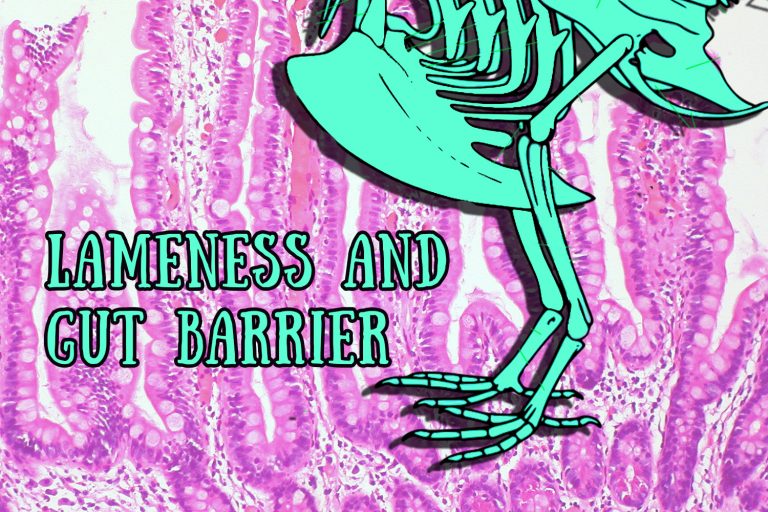
Are your growing and finishing broilers affected by leg problems?
If yes, they may be suffering from a bacterial infection in the head of the femur called Bacterial Chondronecrosis and Osteomyelitis (BCO lameness). BCO lameness is the most common cause of leg problems in broilers (20% of lame birds have BCO) and it is estimated to affect 1.5% of fast growing broiler breeds worldwide when animals are around 5 weeks of age, causing considerable economic losses.
The lesions are most commonly found in long bones, mainly femur and tibia. Rapid growth of broilers and mechanical stresses cause micro-fractures on cartilages, which are colonized by opportunistic bacteria present in blood. The growth of these bacteria on such wound sites leads to necrosis and abscesses.
On necropsy, only in 40-60% of the affected broilers show lesions in bones to the naked eye.
Once BCO has been developed in your birds, it will not respond to treatment, so the smartest strategy is to prevent the disease.
There are two main factors that determine the development of BCO in your flock: the fast growth of skeleton and the presence of bacteria in blood.
1) Fast growth of broiler skeleton
The fastest growing breeds of broilers are the most affected by BCO, because the skeleton does not mature rapidly enough to support the weight of the broiler.
The natural process of bone tissue formation, maturation and calcification is relatively slow but, in commercial broilers, bones are required to grow extremely fast. Over a 6-week period, tibia and femur increase 4-folds in length.
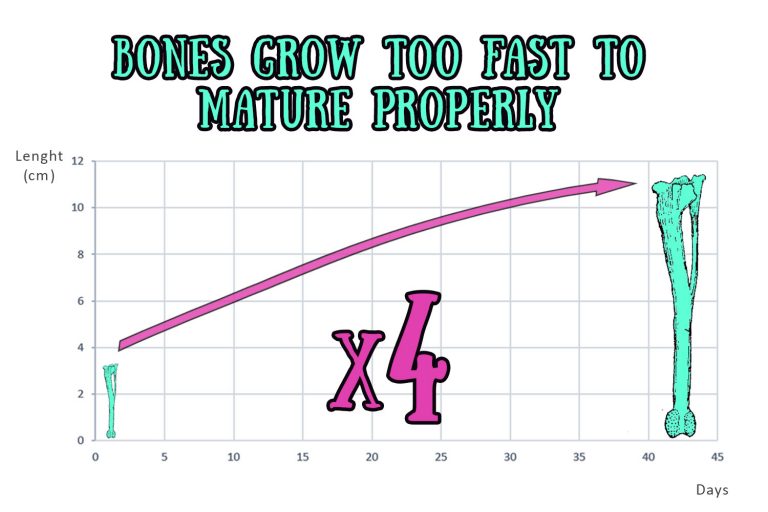
During the growing and finishing stages, the increasing weight of the broilers produces mechanical injuries and micro-fractures and stresses on the immature cartilages of femur, tibia and thoracic vertebrae, especially in the proximal part of the bones. The proximal part of these bones is the most affected because grows faster than the distal part.
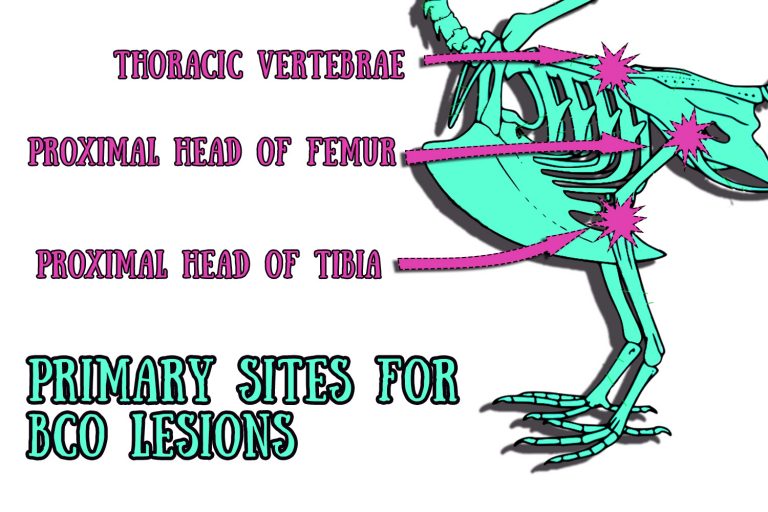
Mechanical injuries damage and disrupt the blood vessels of the cartilages, and, as a consequence:
- Bacteria circulating in blood are able to arrive to the micro-factures and colonize them, starting infections.
- As a consequence of the damage of blood vessels, there will be areas without blood supply (ischemia) and a process of necrosis of the tissues will start.
- As a consequence of the lack of blood supply, bacteria colonizing the micro-fractures are inaccessible to immune cells and also to antibiotic therapy. That’s why BCO does not respond to treatment.
Broilers raised on nets or wires show a higher occurrence of BCO, as these kinds of flooring produce more mechanical stress on the skeleton.
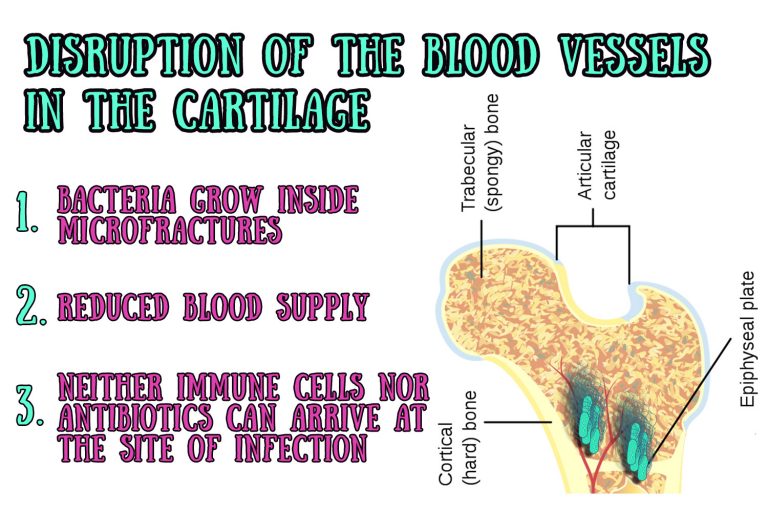
2) Presence of bacteria in blood (bacteremia)
Blood once was thought to be sterile, but recent research has demonstrated that it has its own microbiota, although blood bacteria are dormant and difficult to culture.
The composition of blood microbiota is altered when opportunistic microbes arrive to circulatory system due to changes in the environment or in the health status of the bird. Immunosuppression caused by infections or by environmental stressors is related with the presence of pathogenic bacteria in blood (bacteremia) and the onset of BCO.
The main bacterial species associated with BCO are Staphylococcus spp, Salmonella spp, Escherichia coli and Enterococcus spp. There are four possible sources of these opportunistic species:
- Bacterial translocation in digestive system: bacteria living in digestive system that are able to cross the gut barrier and arrive to blood.
- Bacterial translocation in respiratory system: bacteria that are inhaled into lungs or air sacs and that are able to cross the epithelial barrier and arrive into blood. Viral infections are a risk factor because they damage the epithelial barrier.
- Vertical transmission (transmitted from breeders to embryos); fecal contamination of the eggshell or contamination from hatchery that spreads to the chick.
- Skin scratches and wounds.
Bacterial translocation in digestive system: failure of gut barrier
Within the four possible sources of opportunistic bacteria, bacterial translocation in the digestive system is among the most frequent and also a origin of infection that the broiler farmer has the tools to manage. Very often, the farmer has no decision power on other sources of pathogenic bacteria, such of the quality of breeders or the conditions of the hatchery.
The space between two epithelial cells in digestive epithelium is sealed by tight junctions. Tight junctions must be permeable enough to let nutrient absorption but closed enough to avoid foreign particles and microorganisms to cross the digestive epithelium.
When junctions are “leaky”, gut bacteria are able to penetrate the space between the epithelial cells and arrive to blood, a phenomenon called bacterial translocation.
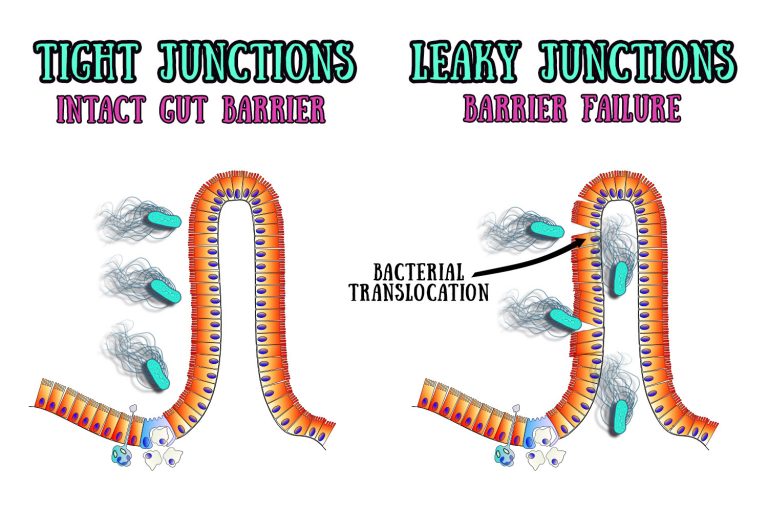
Once opportunistic bacteria have penetrated the leaky junctions, they arrive to blood, spread into the circulatory system of the bird and arrive to bones, where they infect the micro-fractures of the cartilage and start BCO.
There are several factors related with a higher occurrence of leaky junctions and bacterial translocation:
- High amount of pathogenic microorganisms in gut
- Coccidiosis
- Mycotoxins (vomitoxin, fumonisins)
- Impaired local immunity in the digestive system
- Gut inflammation
- Stress, especially heat stress
The importance of gut health
As we learnt above, to reduce the occurrence of BCO in our farm it is necessary to act on the different factors that lead to leaky junctions. Besides avoiding stress, it is necessary to set up a gut health strategy in our farm since day 1 of life of the broiler.
Using a gut health strategy to prevent BCO can cut the occurrence of the disease in your farm by half, with better effectiveness than antibiotics.
A comprehensive gut health strategy should include:
- Feed additives that promote the growth of beneficial bacteria, such as prebiotic plant extracts: beneficial flora boosts local digestive immunity, reduces inflammation and enhances the formation of occlusive tight junction.
- Feed additives that kill pathogenic bacteria, such as microbiocide plant extracts: In previous trials, we demonstrated that the combination of natural prebiotics and microbiocide plant extracts enhances Lactobacillus growth and reduces the presence of pathogens in broiler’s intestine.
- Plant extracts that boost immunity and reduce gut inflammation.
- Mycotoxin binders, paying especial attention to their binding rate for fumonisins and vomitoxin.
- A health program against coccidia.
Administering vitamin D3 to broilers to promote bone strength has also been proven useful as a side strategy to reduce BCO.
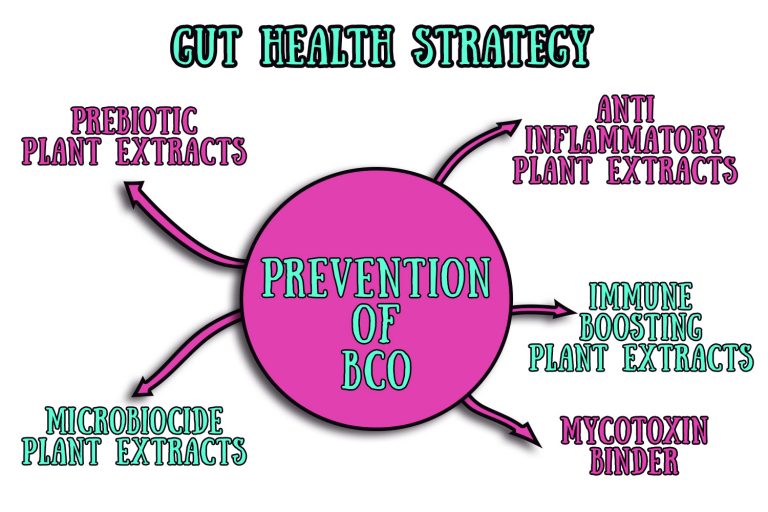
CONCLUSIONS
Bacterial Chondronecrosis and Osteomyelitis (BCO lameness) is a disease of economic importance for worldwide poultry industry. Fast growth of bones in rapidly growth broilers together with presence in blood of bacteria coming from the digestive system are two key factors in BCO. Focusing on gut health since day 1 of life is a safe and effective strategy to prevent the disease.
Products of choice
DigestoCid© is indicated as an acidifier, sanitizer of drinking water and to improve intestinal health in poultry and pigs of all ages. It contains:
- Buffered organic acids, which reduce the pH of the water and inhibit the growth of Gram-negative bacteria.
- Monoester fatty acids, also called medium chain fatty acids, which inhibit the growth of Gram-negative and Gram-positive bacteria. In addition, they have antiviral effects.
- Essential oils and phytochemicals with antibacterial, antifungal, antiviral and antioxidant properties.
DigestoCid© has a broader spectrum of action than products based solely on organic acids, allowing superior antibacterial and antifungal efficacy at a less acidic pH (5.5-6.5).
GrowthPlus© is added to feed to maintain and improve digestive health. It is formulated with synergistic ingredients:
- Bactericidal and fungicidal plant extracts, combined with organic acids for better effectiveness, that reduce the number of pathogenic microbes in the digestive system.
- Plant extracts with prebiotic effect, that promote the growth of beneficial bacteria in the gut.
- Immunostimulant and antioxidant plant extracts.
- Silicates with mycotoxin binding function.
It is especially useful in cases of gizzard diseases, necrotic enteritis, feed passage and other enteritis. It is also used as a natural growth promoter and to replace antibiotic growth promoters.
PlusProtect Digestive© is intended for digestive health in birds and rabbits of all ages. It is formulated with synergistic ingredients:
- Essential oils with bactericidal and fungicidal activity
- Plant extracts with prebiotic effect.
- Immunostimulant and antioxidant essential oils
PlusProtect Digestive© is useful to improve gut health in the following cases:
- Candidiasis in beak, crop and gizzard
- Bacterial infections in gizzard. In severe cases, it is better to give together with our PlusBind© line (mycotoxin binders)
- Bacterial infections in the intestines (necrotic enteritis; E.coli; Salmonella sp.)
- General digestive imbalances, such as feed passage.
PlusBind© is a mixture of carefully selected silicates intended for the prevention of diseases and productivity losses related to the presence of all types of mycotoxins. It is indicated in poultry, pigs, aquaculture and ruminants.
The silicates present in PlusBind© have a highly expandable molecular structure. This characteristic gives the product a wide surface available for the adsorption of mycotoxins and therefore allows a high effectiveness at lower doses (0.5-1 kg per ton of feed).
PlusBind Bio© is a mixture of carefully selected silicates intended for the prevention of diseases and productivity losses related to the presence of all types of mycotoxins. It also contains plant extracts with prebiotic effect.
It is indicated in poultry, pigs and aquaculture.
The silicates present in PlusBind Bio© have a highly expandable molecular structure. This characteristic gives the product a wide surface available for the adsorption of mycotoxins and therefore allows a high effectiveness at lower doses (0.5-1 kg per ton of feed).

Certain health statements may not be applicable in your region.

